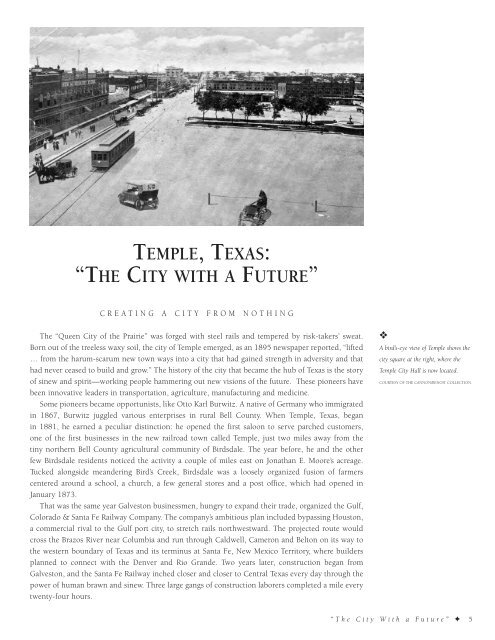Historic Temple
An illustrated history of the city of Temple, Texas, paired with the histories of companies, families and organizations that make the city great.
An illustrated history of the city of Temple, Texas, paired with the histories of companies, families and organizations that make the city great.
You also want an ePaper? Increase the reach of your titles
YUMPU automatically turns print PDFs into web optimized ePapers that Google loves.
TEMPLE, TEXAS:<br />
“THE CITY WITH A FUTURE”<br />
CREATING A CITY FROM NOTHING<br />
The “Queen City of the Prairie” was forged with steel rails and tempered by risk-takers’ sweat.<br />
Born out of the treeless waxy soil, the city of <strong>Temple</strong> emerged, as an 1895 newspaper reported, “lifted<br />
… from the harum-scarum new town ways into a city that had gained strength in adversity and that<br />
had never ceased to build and grow.” The history of the city that became the hub of Texas is the story<br />
of sinew and spirit—working people hammering out new visions of the future. These pioneers have<br />
been innovative leaders in transportation, agriculture, manufacturing and medicine.<br />
Some pioneers became opportunists, like Otto Karl Burwitz. A native of Germany who immigrated<br />
in 1867, Burwitz juggled various enterprises in rural Bell County. When <strong>Temple</strong>, Texas, began<br />
in 1881, he earned a peculiar distinction: he opened the first saloon to serve parched customers,<br />
one of the first businesses in the new railroad town called <strong>Temple</strong>, just two miles away from the<br />
tiny northern Bell County agricultural community of Birdsdale. The year before, he and the other<br />
few Birdsdale residents noticed the activity a couple of miles east on Jonathan E. Moore’s acreage.<br />
Tucked alongside meandering Bird’s Creek, Birdsdale was a loosely organized fusion of farmers<br />
centered around a school, a church, a few general stores and a post office, which had opened in<br />
January 1873.<br />
That was the same year Galveston businessmen, hungry to expand their trade, organized the Gulf,<br />
Colorado & Santa Fe Railway Company. The company’s ambitious plan included bypassing Houston,<br />
a commercial rival to the Gulf port city, to stretch rails northwestward. The projected route would<br />
cross the Brazos River near Columbia and run through Caldwell, Cameron and Belton on its way to<br />
the western boundary of Texas and its terminus at Santa Fe, New Mexico Territory, where builders<br />
planned to connect with the Denver and Rio Grande. Two years later, construction began from<br />
Galveston, and the Santa Fe Railway inched closer and closer to Central Texas every day through the<br />
power of human brawn and sinew. Three large gangs of construction laborers completed a mile every<br />
twenty-four hours.<br />
❖<br />
A bird’s-eye view of <strong>Temple</strong> shows the<br />
city square at the right, where the<br />
<strong>Temple</strong> City Hall is now located.<br />
COURTESY OF THE CANNON/BENOIT COLLECTION.<br />
“The City With a Future” ✦ 5
















